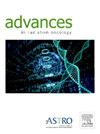Setup Accuracy and Efficiency of Real-Time Video Assistance for Surface-Guided Positioning in Radiation Therapy of Right-Sided Locoregional Breast Cancer
IF 2.7
Q3 ONCOLOGY
引用次数: 0
Abstract
Purpose
Real-time video assistance in combination with surface guidance (SG) has been introduced in radiation therapy. In this study, we wanted to investigate the efficiency and accuracy of this new procedure for patients with right-sided locoregional breast cancer with special focus on the arm position.
Methods and Materials
Twenty-six patients were included. Each patient was positioned using SG with real-time video assistance for half of the fractions. For the other half of the fractions, patient’s surface was captured (including arm position) and visually compared to the reference surface before adjusting the patient position. This process was repeated until the patient position was acceptable. Pretreatment cone beam computer tomography (CBCT) was acquired at every fraction. Couch shifts after CBCT match were used to calculate systematic and random errors. CBCTs were also used to compare the actual treatment position of the nodal areas to the planned position. To analyze setup efficiency, 6 time points during the whole treatment procedure were recorded and analyzed.
Results
Our results showed negligible differences in setup accuracy when comparing couch shifts after CBCT match and the treated position of the nodal area. The group mean of the vertical couch shifts was significantly different between the 2 setup procedures (P = .03). The systematic error and the random error, however, were identical or almost identical. No other metrics regarding setup accuracy were significantly different. Setup efficiency was significantly improved using SG with real-time video assistance. By implementing real-time video assistance, setup time was reduced by an average of 40 seconds
Conclusions
By implementing real-time video assistance in the setup of patients with right-sided locoregional breast cancer using SG, setup time can be significantly reduced without compromising setup accuracy.
右侧局部乳腺癌放射治疗中表面引导定位实时视频辅助的设置精度和效率
目的实时视频辅助与表面引导(SG)结合应用于放射治疗。在这项研究中,我们想研究这种新手术对右侧局部区域乳腺癌患者的效率和准确性,特别关注手臂位置。方法与材料选取26例患者。每个患者使用SG定位,实时视频辅助一半的分数。对于另一半分数,在调整患者位置之前,捕获患者表面(包括手臂位置)并与参考表面进行视觉比较。重复此过程,直到患者体位可接受为止。在每个分数处进行预处理锥形束计算机断层扫描(CBCT)。采用CBCT匹配后的Couch shift计算系统误差和随机误差。cbct还用于比较实际治疗位置与计划位置的结区。为了分析设置效率,记录并分析整个治疗过程中的6个时间点。结果在比较CBCT匹配后的沙发移位和治疗后的淋巴结位置时,我们的结果显示设置准确性的差异可以忽略不计。两种设置过程中,竖直沙发移位的组平均值有显著差异(P = .03)。然而,系统误差和随机误差是相同或几乎相同的。关于设置精度的其他指标没有显着差异。使用SG和实时视频辅助,设置效率显着提高。通过实施实时视频辅助,平均减少了40秒的设置时间。结论通过在使用SG的右侧局部区域乳腺癌患者的设置中实施实时视频辅助,可以显着减少设置时间,而不影响设置准确性。
本文章由计算机程序翻译,如有差异,请以英文原文为准。
求助全文
约1分钟内获得全文
求助全文
来源期刊

Advances in Radiation Oncology
Medicine-Radiology, Nuclear Medicine and Imaging
CiteScore
4.60
自引率
4.30%
发文量
208
审稿时长
98 days
期刊介绍:
The purpose of Advances is to provide information for clinicians who use radiation therapy by publishing: Clinical trial reports and reanalyses. Basic science original reports. Manuscripts examining health services research, comparative and cost effectiveness research, and systematic reviews. Case reports documenting unusual problems and solutions. High quality multi and single institutional series, as well as other novel retrospective hypothesis generating series. Timely critical reviews on important topics in radiation oncology, such as side effects. Articles reporting the natural history of disease and patterns of failure, particularly as they relate to treatment volume delineation. Articles on safety and quality in radiation therapy. Essays on clinical experience. Articles on practice transformation in radiation oncology, in particular: Aspects of health policy that may impact the future practice of radiation oncology. How information technology, such as data analytics and systems innovations, will change radiation oncology practice. Articles on imaging as they relate to radiation therapy treatment.
 求助内容:
求助内容: 应助结果提醒方式:
应助结果提醒方式:


